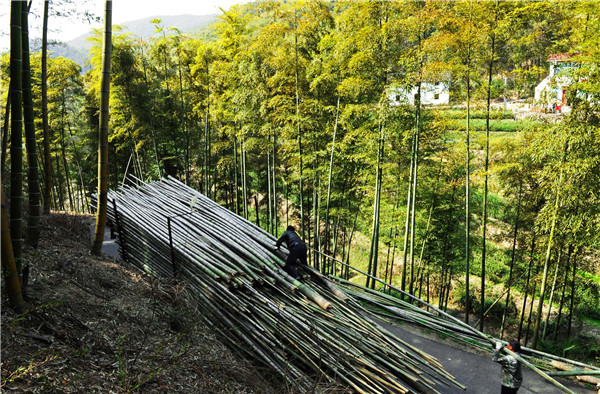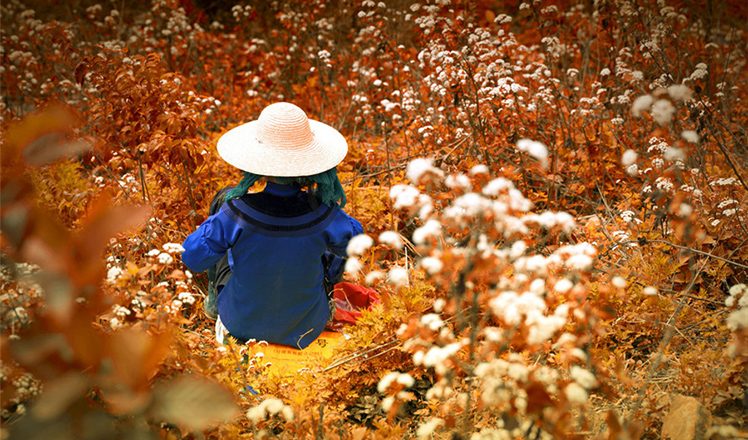Bamboo hullaballoo
Updated: 2016-09-21 08:14
By Xu Lin and Erik Nilsson(China Daily)
|
||||||||
 |
|
The county of Anji in Zhejiang province is a leading Chinese ecotourism county because of its rich cultural and natural landscape. [Photo provided to China Daily] |
That's not to mention human fare. And the cutlery you eat it with. And the plates you put it on. And the table you put those on. And the bamboo flooring you put the table on. And the bamboo roof you put that under.
And so on.
Locals recall bamboo roofing saved their lives during the flash floods of decades past. They'd crawl atop rooftops and float away on them like life rafts.
The plant also presents green opportunities environmentally.
It can easily be grown organically. It gulps pesticides from the soil while guzzling copious CO2 from the air.
Bamboo processing typically requires fewer toxins than generating goods from trees.
It's expediently renewable. It can be harvested in short spans.
Some varieties grow so fast that you can hear them creak as they stretch toward the sky. They're like Jack's beanstalks. Perhaps louder.
Industrial users produce Anji's bamboo that in turn protects the environment and adorns the terrain. That in turn lures tourists-producing a symbiosis of ecology and commerce.
The plant has for millennia occupied a revered position in Chinese culture.
It's among the first subjects traditional painters are required to master.
It shares the distinction as one of the "four gentlemen", along with the orchid, plum blossom and chrysanthemum. Ancient scholars venerated it as an icon of longevity and endurance-a concept that has long endured to extend to ordinary folks today.
Anji hosts over 300 species. The bamboo its people cultivate, in turn, cultivates its people.
"Chinese culture is bamboo culture," local agricultural expert Xuan Taotao explains. "Bamboo can make farmers rich and our environment healthy. So we must preserve bamboo forests and industries."
It's cyclical.
Roofed corridors in Anji's bamboo forests are fashioned out of bamboo forests.
Spring Alpha Resort offers not only guestrooms ornamented with bamboo handicrafts but also lessons in handcrafting bamboo ornaments.
Buildings designed according to Ming (1368-1644) and Qing (1644-1911) dynastic architecture with contemporary flourishes are arranged in courtyard gardens with stone bridges, pavilions and rockeries.
Its commercial street is lined with snack stores, souvenir shops, two bars and a theater where visitors can sip Anji white tea while savoring traditional Shaoxing Opera.
The resort also offers karaoke, mahjong and spa treatments.
Spring Alpha's allure, like much of the county's, is based on the trend in which more Chinese seek more leisure over mere sightseeing.
And ecotourism like Anji's-which is conversely supported by sustainable agro-industrial production-accommodates both desires.
Contact the writers through xulin@chinadaily.com.cn
China Daily explores the country's shades of green in this series.
If you go
Buses from Jiangsu and Zhejiang provinces are convenient.
Anji is roughly 220 kilometers from Shanghai and about 75 km from Zhejiang province's capital, Hangzhou. Visitors from Beijing can take the high-speed train to Hangzhou for about five hours and then ride a bus for roughly 1.5 hours.
Most Viewed
Editor's Picks

|

|

|

|

|

|
Today's Top News
Trump outlines anti-terror plan, proposing extreme vetting for immigrants
Phelps puts spotlight on cupping
US launches airstrikes against IS targets in Libya's Sirte
Ministry slams US-Korean THAAD deployment
Two police officers shot at protest in Dallas
Abe's blame game reveals his policies failing to get results
Ending wildlife trafficking must be policy priority in Asia
Effects of supply-side reform take time to be seen
US Weekly

|

|















